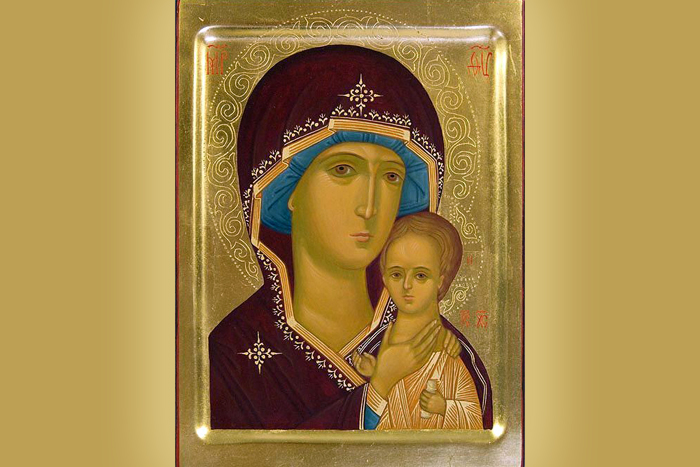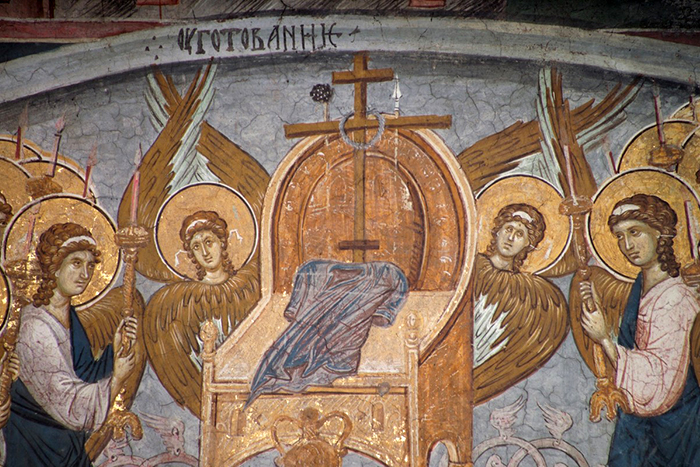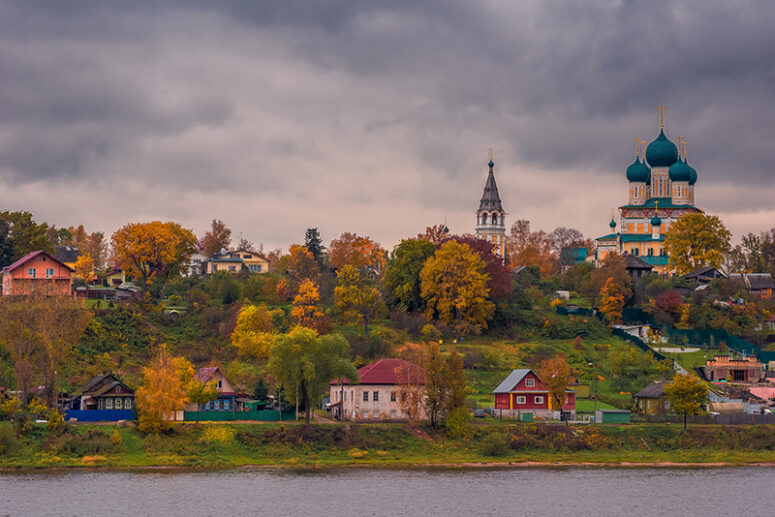
The first sacred object that appeared through Divine Will in the heart of Russia and survived to our days is the Icon of the All-Merciful Saviour in Borisoglebsk. It is perhaps the world’s largest portable icon of Jesus Christ, and multiple miracles attributed are to it. The second is the icon of the Mother of God “Giver of Wisdom”, believed to be among the oldest iconographic images of the Theotokos. It has a remarkable history and bears a resemblance to a famous Italian statue. Both are found in the Orthodox churches of Tutaev, a medium-sized city of Russia’s Yaroslavl Region.
The All-merciful Saviour
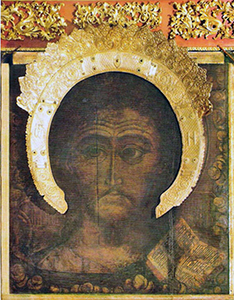
Dated to the 15th century, this depiction of the Saviour is linked to the Russian city named Borisoglebsk, where it is kept at the Church of the Resurrection. In 1822, this city merged with the neighbouring town of Romanov and received the name Romanov-Borisoglebsk, and in 1918 it changed its name to Tutaev by a decree of the Soviet government.
The icon’s size is an impressive three metres in length and width. Experts believe that its large size fitted its original purpose – to cover an area in the domed ceiling of the wooden monastery church that preceded the Cathedral of the Resurrection. Depictions of the clouds around the face of the Saviour along the edges support this theory.
Several versions exist concerning the origins of the icon and the identity of the painter. According to one common legend, the Icon of the All-Merciful Saviour was painted in the 15th century by Dionysus Glushitsky, an iconographer. Other narratives suggest, that the icon may have drifted down the River Volga and was found at the river back in the city, or it could have been a gift for the local duke from some foreign monks.
When the Cathedral of the Resurrection was completed in the 17th century, the icon was placed in the deaconry in the upper part of the cathedral, and an annexe was built and consecrated thee several years later. By that time, the icon’s popularity had subsided, and many of the pilgrims who came to venerate it were old believers. In 1749, Metropolitan Arsenius of Rostov and Yaroslavl arrived in Borisoglebsk with a mandate to close all chapels of the old believers. Finding out about the icon, he ordered to take it away to the residence of the archpriest in Rostov, indicating that he needed to take every step to prevent the deepening of the rift within the church with the old believers. It was not until forty-four years later when a different Metropolitan of Rostov gave his permission to return the icon to the Cathedral of the Resurrection. People carried the icon from Rostov to Borisoglebsk in their hands. Three kilometres from the destination, the procession stopped at the bank of the Kovat River to clean the icon from the dust before entering the city. According to tradition, a holy spring broke out at the place of the stopover, and a wooden chapel was built next to it several years later.
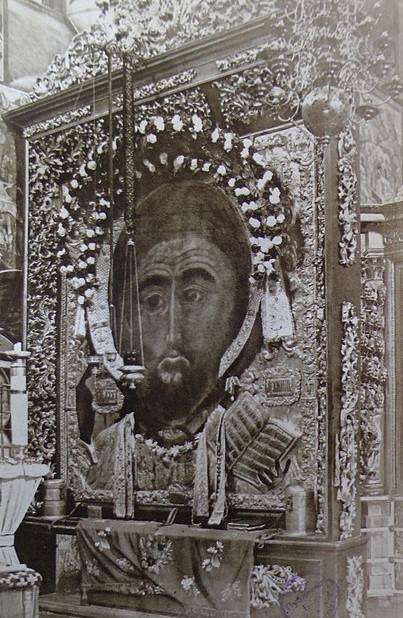
In the Cathedral of the Resurrection, the people placed the icon in a tabernacle made especially for it. Under the tabernacle found in the middle of the church, they built a passage where people had to kneel to come to the icon. According to eyewitnesses, many people who did so with humility were healed from their afflictions. In the 19th century, pendants in the form of arms and legs were added to the icon in gratefulness from the sick for the healing of their limbs. With donations from the faithful, the icon was decorated with a Riza and crown.
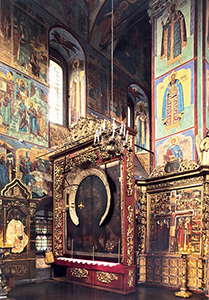
The image itself also merits a detailed description. The depiction of the Saviour has dimmed over time and is barely distinguishable under a layer of soot and flax oil. The icon is a waste-deep depiction of Christ, despite its unusual proportions. The right hand of the saviour is raised, and his left hand is holding an open gospel. To Yury Shamurin, a historian and art critic, the icon of the All-Merciful Saviour represents divine asceticism, and love, the greatness of the Lord and His earthly torments, His compassion for the sinful and helpless man…”, and the depiction of His face was as enigmatic and mysterious as the smile of the Gioconda. Standing out amid the bright colours of the church’s wall frescos, the dimness of the icon underlines and adds to its beauty. It draws our attention to the image of our ultimate reality – our Lord and Saviour Jesus Christ.
Despite its size, the icon is often moved from the winter church to the summer church. Every six months, the faithful carry it around the town in a procession of the cross, on the ninth Sunday from the Pascha and on the last Sunday before the feast of the Prophet Elijah.

Icon of the Mother of God “Giver of Wisdom”
Experts believe that this image of the Theotokos is grounded in the iconographic tradition of the sixteenth century, influenced by the icons and prints from Western Europe. However, most surviving icons date back to the 18th and 19th centuries.
The church tradition provides an alternative, and arguably a more attractive account about its origin. Sometime at the turn of the 18th century there lived in Moscow a pious icon painter. He had read a wealth of religious books written under Patriarch Joseph and had just begun to read the authors who wrote in the age of his successor, Nikon. After reading both sets of literature, he asked himself, “Which writings are more congruent with God’s teachings? Which should guide me in my progress to salvation.” His doubts and reflections were so intense that the poor iconographer went out of his mind but never found the answer. In the rare moments when the soundness of mind returned to him, he prayed to the Mother of God, imploring her to give him back his wisdom. The Holy Theotokos heard his prayers. She came to the iconographer in a dream and instructed him to paint her image the way he saw Her, and the soundness of your mind will return to you by your prayers. After his vision, the iconographer used his every moment of soundness to write the icon. However, as he was painting, he kept forgetting important details, as the vision of very short. Again, he prayed to the Mother of God, and the Holy Spirit guided his hand. Finally, he completed the icon and upon his healing, he gave it the name “Giver of Wisdom”.
![]()
In the oldest image found at the Church of the Protection in Tutaev, the Theotokos and Baby Christ are depicted wearing royal wreaths. With his right hand raised in a blessing, Christ is holding a sceptre in his left. The icon is easy to recognise by some of its outstanding features. The bodies of the Mother of God and the Saviour are covered by a long and colourful cloak shaped like a bell. Both are depicted standing in an arc, in the rays of the divine light. On either side of them are two pairs of angels with candles. Three Seraphims hover above them, and a Cherubim stands at their feed. Underneath them lies a city, representing Jerusalem in Heaven. Depictions of a night sky with stars appeared in later versions of the image.
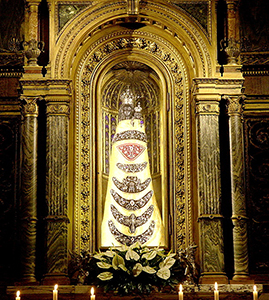
In the early 20th century, the Russian scholar Andrey Titov suggested that the statue of the Virgin Mary of Loretta could be the prototype of the icon “Giver of Wisdom” The statue stands in the Holy Tabernacle of the Mother of God brought from Nazareth. The statue of Mary is made from Cedar and decorated with diamond laces and pearl threads. The scholar is convinced that all known images of the Theotokos “Giver of Wisdom” have basic similarities with this prototype, with some local (‘Muscovite’) features added to them. In the 20th century, Titov’s works gained recognition among Italian historians and art critics. Today, any traveller to Loretta may bring back with him as a souvenir a printed copy of the icon “Giver of Wisdom” with the inscription “Virgin Mary of Loretta, 18th-century Russian icon”.
This 18th-century image of the Holy Theotokos “Giver of Wisdom” is found in the Tikhvin Church in Moscow.
The faithful pray before this image for help in learning and studying, and can expect that the Most Holy Theotokos will hear them and come to their aid.



